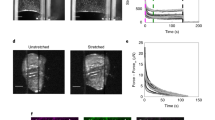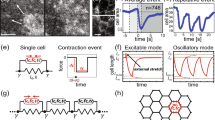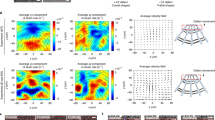Abstract
Throughout embryonic development and adult life, epithelia are subjected to compressive deformations. While these have been shown to trigger mechanosensitive responses such as cell extrusion and differentiation, which span tens of minutes, little is known about how epithelia adapt to compression over shorter timescales. Here, using suspended epithelia, we uncover the immediate response of epithelial tissues to the application of in-plane compressive strains (5–80%). We show that fast compression induces tissue buckling followed by actomyosin-dependent tissue flattening that erases the buckle within tens of seconds, in both mono- and multi-layered epithelia. Strikingly, we identify a well-defined limit to this response, so that stable folds form in the tissue when compressive strains exceed a ‘buckling threshold’ of ~35%. A combination of experiment and modelling shows that this behaviour is orchestrated by adaptation of the actomyosin cytoskeleton as it re-establishes tissue tension following compression. Thus, tissue pre-tension allows epithelia to both buffer against deformation and sets their ability to form and retain folds during morphogenesis.
This is a preview of subscription content, access via your institution
Access options
Access Nature and 54 other Nature Portfolio journals
Get Nature+, our best-value online-access subscription
$29.99 / 30 days
cancel any time
Subscribe to this journal
Receive 12 print issues and online access
$259.00 per year
only $21.58 per issue
Buy this article
- Purchase on Springer Link
- Instant access to full article PDF
Prices may be subject to local taxes which are calculated during checkout





Similar content being viewed by others
Data availability
The data that support the findings of this study are available from the corresponding authors upon reasonable request.
Code availability
All code created for the analysis of the data in this study is available from the corresponding authors upon reasonable request.
References
Tschumperlin, D. J. et al. Bronchial epithelial compression regulates MAP kinase signaling and HB-EGF-like growth factor expression. Am. J. Physiol. Lung. Cell. Mol. Physiol. 282, L904–L911 (2002).
Martin, A. C., Kaschube, M. & Wieschaus, E. F. Pulsed contractions of an actin–myosin network drive apical constriction. Nature 457, 495–499 (2009).
Shyer, A. E. et al. Emergent cellular self-organization and mechanosensation initiate follicle pattern in the avian skin. Science 357, 811–815 (2017).
Etournay, R. et al. Interplay of cell dynamics and epithelial tension during morphogenesis of the Drosophila pupal wing. eLife 4, e07090 (2015).
Brodland, G. W. et al. Video force microscopy reveals the mechanics of ventral furrow invagination in Drosophila. Proc. Natl Acad. Sci. USA 107, 22111–22116 (2010).
Sidhaye, J. & Norden, C. Concerted action of neuroepithelial basal shrinkage and active epithelial migration ensures efficient optic cup morphogenesis. eLife 6, 1–29 (2017).
Shyer, A. E. et al. Villification: how the gut gets its Villi. Science 342, 212–218 (2013).
Park, J.-A. et al. Unjamming and cell shape in the asthmatic airway epithelium. Nat. Mater. 14, 1040–1048 (2015).
Grainge, C. L. et al. Effect of bronchoconstriction on airway remodeling in asthma. N. Engl. J. Med. 364, 2006–2015 (2011).
Tallinen, T. et al. On the growth and form of cortical convolutions. Nat. Phys. 12, 588–593 (2016).
Aragona, M. et al. A mechanical checkpoint controls multicellular growth through YAP/TAZ regulation by actin-processing factors. Cell 154, 1047–1049 (2013).
Desprat, N., Supatto, W., Pouille, P. A., Beaurepaire, E. & Farge, E. Tissue deformation modulates twist expression to determine anterior midgut differentiation in drosophila embryos. Dev. Cell 15, 470–477 (2008).
Eisenhoffer, G. T. et al. Crowding induces live cell extrusion to maintain homeostatic cell numbers in epithelia. Nature 484, 546–549 (2012).
Marinari, E. et al. Live-cell delamination counterbalances epithelial growth to limit tissue overcrowding. Nature 484, 542–545 (2012).
Wyatt, T., Baum, B. & Charras, G. A question of time: Tissue adaptation to mechanical forces. Curr. Opin. Cell Biol. 38, 68–73 (2016).
Étienne, J. et al. Cells as liquid motors: mechanosensitivity emerges from collective dynamics of actomyosin cortex. Proc. Natl Acad. Sci. USA 112, 2740–2745 (2015).
Chanet, S. et al. Actomyosin meshwork mechanosensing enables tissue shape to orient cell force. Nat. Commun. 8, 1–13 (2017).
Clément, R., Collinet, C., Dehapiot, B., Lecuit, T. & Lenne, P. Viscoelastic dissipation stabilizes cell shape changes during tissue morphogenesis. Curr. Biol. 27, 3132–3142 (2017).
Harris, A. R. et al. Characterizing the mechanics of cultured cell monolayers. Proc. Natl Acad. Sci. USA 109, 16449–16454 (2012).
Harris, A. R. et al. Generating suspended cell monolayers for mechanobiological studies. Nat. Protoc. 8, 2516–2530 (2013).
Wyatt, T. P. J. et al. Emergence of homeostatic epithelial packing and stress dissipation through divisions oriented along the long cell axis. Proc. Natl Acad. Sci. USA 112, 5726–5731 (2015).
Salbreux, G., Charras, G. & Paluch, E. Actin cortex mechanics and cellular morphogenesis. Trends Cell Biol. 22, 536–545 (2012).
Fischer-Friedrich, E. et al. Rheology of the active cell cortex in mitosis. Biophys. J. 111, 589–600 (2016).
Hutson, M. S. et al. Forces for morphogenesis investigated with laser microsurgery and quantitative modeling. Science 300, 145–149 (2003).
Valon, L., Marín-Llauradó, A., Wyatt, T., Charras, G. & Trepat, X. Optogenetic control of cellular forces and mechanotransduction. Nat. Commun. 8, 14396 (2017).
Tambe, D. T. et al. Collective cell guidance by cooperative intercellular forces. Nat. Mater. 10, 469–475 (2011).
Audoly, B. & Pomeau, Y. Elasticity and Geometry. From Hair Curls to the Non-linear Response of Shells (Oxford Univ. Press, 2010).
Bonnet, I. et al. Mechanical state, material properties and continuous description of an epithelial tissue. J. R. Soc. Interface 9, 2614–2623 (2012).
Bambardekar, K., Clément, R., Blanc, O., Chardès, C. & Lenne, P.-F. Direct laser manipulation reveals the mechanics of cell contacts in vivo. Proc. Natl Acad. Sci. USA 112, 1416–1421 (2015).
Kassianidou, E., Brand, C. A., Schwarz, U. S. & Kumar, S. Geometry and network connectivity govern the mechanics of stress fibers. Proc. Natl Acad. Sci. USA 114, 2622–2627 (2017).
Khalilgharibi, N., Fouchard, J., Recho, P., Charras, G. & Kabla, A. The dynamic mechanical properties of cellularised aggregates. Curr. Opin. Cell Biol. 42, 113–120 (2016).
Weibel, E. R. On the tricks alveolar epithelial cells play to make a good lung. Am. J. Respir. Crit. Care Med. 191, 504–513 (2015).
Pastor-Pareja, J. C. & Xu, T. Shaping cells and organs in drosophila by opposing roles of fat body-secreted collagen IV and perlecan. Dev. Cell 21, 245–256 (2011).
Davidson, L. A., Keller, R. & DeSimone, D. W. Assembly and remodeling of the fibrillar fibronectin extracellular matrix during gastrulation and neurulation in Xenopus laevis. Dev. Dyn. 231, 888–895 (2004).
Nelson, C. M. On buckling morphogenesis. J. Biomech. Eng. 138, 021005 (2016).
Lecuit, T. & Lenne, P.-F. Cell surface mechanics and the control of cell shape, tissue patterns and morphogenesis. Nat. Rev. Mol. Cell Biol. 8, 633–644 (2007).
Kocgozlu, L. et al. Epithelial cell packing induces distinct modes of cell extrusions. Curr. Biol. 26, 2942–2950 (2016).
Costa, K. D., Hucker, W. J. & Yin, F. C. P. Buckling of actin stress fibers: a new wrinkle in the cytoskeletal tapestry. Cell Motil. Cytoskeleton 52, 266–274 (2002).
Tofangchi, A., Fan, A. & Saif, M. T. A. Mechanism of axonal contractility in embryonic drosophila motor neurons in vivo. Biophys. J. 111, 1519–1527 (2016).
Chan, T. F. & Vese, L. A. Active contours without edges. IEEE Trans. Image Process. 10, 266–277 (2001).
Schindelin et al. Fiji: an open-source platform for biological-image analysis. Nat. Methods 9, 676–682 (2012).
Aigouy, B. et al. Cell flow reorients the axis of planar polarity in the wing epithelium of drosophila. Cell 142, 773–786 (2010).
van der Walt et al. scikit-image: image processing in Python. PeerJ 2, e453 (2014).
Acknowledgements
The authors wish to acknowledge past and present members of the Charras, Baum and Kabla laboratories and Ys for stimulating discussions as well as D. Farquharson and S. Townsend at the UCL workshop. T.P.J.W. and N.K. were part of the EPSRC funded doctoral training programme CoMPLEX. J.F. and P.R. were funded by BBSRC grants (nos. BB/M003280 and BB/M002578) to G.T.C. and A.J.K. N.K. was funded by the Rosetrees Trust and the UCL Graduate School through a UCL Overseas Research Scholarship. A.L. was supported by an EMBO long-term post-doctoral fellowship. B.B. was supported by UCL, a BBSRC project grant (no. BB/K009001/1) and a CRUK programme grant (no. 17343). T.P.J.W., J.F., N.K., A.L. and G.T.C. were supported by a consolidator grant from the European Research Council to G.T.C. (MolCellTissMech, agreement no. 647186).
Author information
Authors and Affiliations
Contributions
T.P.J.W., J.F., B.B. and G.T.C. designed the experiments. T.P.J.W., J.F., A.L. and N.K. carried out the experiments. T.P.J.W. and J.F. performed the data and image analysis. P.R. and A.J.K. designed the rheological model. T.P.J.W., J.F., B.B. and G.T.C. wrote the manuscript. All authors discussed the results and manuscript.
Corresponding authors
Ethics declarations
Competing interests
The authors declare no competing interests.
Additional information
Publisher’s note: Springer Nature remains neutral with regard to jurisdictional claims in published maps and institutional affiliations.
Supplementary information
Supplementary Information
Supplementary Figs. 1–6, Supplementary Notes 1–4, Supplementary refs. 1–4 and Supplementary Video 1–9.
Supplementary Video 1
Epithelial response to fast −35% strain application.
Supplementary Video 2
Epithelial response to fast −50% strain application.
Supplementary Video 3
Epithelial response to slow −80% strain application.
Supplementary Video 4
HaCaT response to fast −35% strain application.
Supplementary Video 5
HaCaT response to fast −50% strain application.
Supplementary Video 6
HaCaT response to slow −80% strain application.
Supplementary Video 7
Epithelial flattening requires actomyosin activity.
Supplementary Video 8
Dependence of flattening time on strain history.
Supplementary Video 9
Reversibility of the change in flattening time.
Rights and permissions
About this article
Cite this article
Wyatt, T.P.J., Fouchard, J., Lisica, A. et al. Actomyosin controls planarity and folding of epithelia in response to compression. Nat. Mater. 19, 109–117 (2020). https://doi.org/10.1038/s41563-019-0461-x
Received:
Accepted:
Published:
Issue Date:
DOI: https://doi.org/10.1038/s41563-019-0461-x
This article is cited by
-
Friction forces determine cytoplasmic reorganization and shape changes of ascidian oocytes upon fertilization
Nature Physics (2024)
-
Compressive forces stabilize microtubules in living cells
Nature Materials (2023)
-
Collective curvature sensing and fluidity in three-dimensional multicellular systems
Nature Physics (2022)
-
Static and dynamic mechanics of cell monolayers: A multi-scale structural model
Acta Mechanica Sinica (2022)
-
Brick Strex: a robust device built of LEGO bricks for mechanical manipulation of cells
Scientific Reports (2021)



